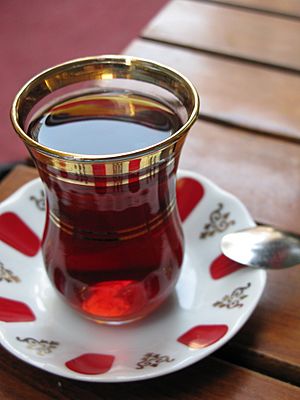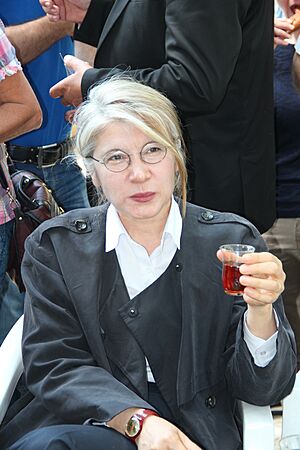Tea in Turkey facts for kids
Tea (Turkish: çay) is a super popular drink in Turkey and for Turkish people living in other countries. Turkey actually drinks the most tea per person in the whole world! People there drink over 3 kilograms of tea each year. Turkey also sells a lot of tea to other countries, being one of the top five tea exporters. Tea is a big part of social life in Turkey, enjoyed in tea houses and gardens. It's also sometimes used as a herbal medicine. The tradition of drinking Turkish tea is also strong in Northern Cyprus and some countries in the Balkan Peninsula. Tea has a long and interesting history in Turkey, becoming a huge part of their culture since it was first introduced.
Contents
Tea Grown in Turkey
Since the mid-1900s, most of the tea grown in Turkey has been Rize tea. This special tea comes from the Rize Province on the Eastern Black Sea coast. Rize has a perfect climate for tea, with lots of rain and rich soil.
In 2019, Turkey grew about 1.45 million tonnes of tea. That was about 4% of all the tea grown worldwide! Turkey is one of the biggest tea markets, with most of that tea (1.26 million tonnes) being drunk right there. As mentioned, Turks drink the most tea per person, about 3.5 kg each year. That's almost four glasses every day! Turkey has high taxes on imported tea, which helps local tea growers sell their products.
However, by 2023, tea production dropped to just over 500,000 tonnes. This happened because of hot weather and unusual rainfall.
History of Turkish Tea
Early Days of Tea in Turkey
Tea first arrived in what is now Turkey around the 5th century. It was brought by traders traveling the Silk Road. They used tea to trade for goods from China. By the end of the 6th century, drinking tea became very popular. It was no longer just seen as a medicine.
Later, in the 1800s, a nearby city called Batumi (which is now in Georgia) started growing tea very successfully. The Russians had started this tea farming by bringing tea plants from China. Seeing this success, the Russians thought about growing tea in Turkey too.
In 1888, the Department of Agriculture in Turkey tried to grow tea in the city of Bursa. They brought tea plants from Japan and China to see if it would work. But the land in Bursa wasn't right for growing tea.
Tea in the 1900s
People were encouraged to drink tea instead of coffee after the dissolution of the Ottoman Empire. Coffee became very expensive and sometimes hard to find after World War I. This was because the area where coffee was traditionally grown was no longer part of Turkey. So, tea became a cheaper and easier drink to get.
The first attempts to grow tea in Rize Province started in 1912. This idea came from Hulusi Bey, who was the Head of the Chamber of Agriculture.
In 1918, a plant expert named Ali Riza Erten was asked by the government to try growing tea in other parts of Turkey. These areas included Rize, Artvin Province, Ardahan Province, and Batumi in Georgia. He took detailed notes on what made tea grow well in Batumi. He then tried to find similar places in Turkey. Erten eventually decided that Rize, Artvin, and Ardahan were the best places. However, at this time, Turkey and its neighbors were in a lot of trouble, so growing tea wasn't the main focus. His research wasn't used for another 10 years.
By 1924, the government set up the Central Tea Nursery. This place gave out about 50,000 young tea plants in Rize province. Farmers learned how to prune tea plants, what fertilizers to use, and how to process the leaves faster. Many early tea farmers gave up because they didn't know enough and didn't make money at first.
From 1939 to 1945, large tea farms were finally created and became stable. Rize Province quickly became Turkey's main tea-growing area. Tea became one of the most important farm products in the country. Some towns in the Black Sea region even changed their names to include the word çay (tea). For example, Kadahor became Çaykara and Mapavri became Çayeli.
By the mid-1900s, tea was the most popular drink in Turkey.
In the 1950s, the government saw that the tea industry could really help the Black Sea province. This area had not been very well-off. So, the government strongly supported the tea industry to improve living conditions. Even though the ruling party believed in a free market, they protected the tea industry to help it grow. As the tea industry became richer, the North Anatolian province also improved. New roads, schools, hospitals, and other important buildings were built.
In the 1970s, political struggles slowed down tea production and modernization. This fighting between politicians caused prices to go up, which made the value of goods like tea go down. Because prices dropped and people were unhappy with the government, many tea growers stopped following the quality rules set by the Tea Corporation. This Corporation was a state-owned company that bought most of the tea leaves. To make sure the tea was good enough to sell to other countries, the Corporation had strict rules for harvesting. But the inspectors, who were often tea growers themselves, often ignored these rules because they knew farmers were struggling. As a result, the quality of Turkish tea became noticeably worse.
The 1980 coup brought a strong central government. This government changed tea production and its rules a lot. Growers were told to follow the Tea Corporation's quality standards. They had to pick tea by hand and had limits on how much they could pick each day. This caused production to drop.
The 1983 elections brought back the same political party. Soon after, the Tea Corporation's control over the tea industry was ended. Private companies could now enter the tea business. Tea growers liked this because many small private companies didn't care as much about the quality rules as the Corporation did. Even with new companies, the Tea Corporation remained the biggest buyer. But the excitement about private companies didn't last long. Many companies went out of business or were slow to pay the harvesters. Workers went back to selling to the Corporation because they trusted it more, especially with payments.
After the 1991 elections, a new government came into power. They used the Tea Corporation to create more jobs in the tea sector, hoping to gain more support.
Tea and Money
In 2018, Germany bought the most Turkish tea. Between January and August, Turkey earned about 770,000 US dollars from selling tea to Germany. Turkey sold almost 1,500 tonnes of its tea that year, worth 5.7 million US dollars. As of 2017, Turkey is the fifth largest tea exporter in the world.
COVID-19's Effect on Tea
During the COVID-19 pandemic, the Black Sea province saw changes in who was working during the tea harvest. Usually, about 40,000 workers came from places like Georgia and Azerbaijan. But because of the pandemic, they couldn't enter the country. So, African immigrants, mainly from Gambia and Senegal, who already lived in Turkey with visas, filled these jobs.
The government made it easier for tea harvesters to travel to the Rize province within Turkey. However, these workers had to quarantine for fourteen days before they could start working.
How Tea is Drunk in Turkey
Turkish tea is usually made using two special teapots stacked on top of each other. This is called a "çaydanlık." Water is boiled in the larger teapot at the bottom. Then, some of this hot water is poured into the smaller teapot on top, where several spoons of loose tea leaves are steeping. This makes a very strong tea. When it's served, the remaining hot water from the bottom pot is used to dilute the strong tea. This way, each person can choose if they want their tea strong (Turkish: koyu, meaning "dark") or weak (Turkish: açık, meaning "light").
Tea is drunk from small, tulip-shaped glasses called ince belli. This name means "slim-waisted." These glasses help keep the tea hot and show off its beautiful red color. Istanbul has a thriving glass-making industry that produces these traditional tea glasses. About 400 million of these glasses are sold in Turkey every year. People usually hold these glasses by the rim so their fingers don't get burned, as the tea is served very hot.
Traditionally, tea is served with small cubes of beet sugar. It is almost never drunk with milk or lemon. Sweet or savory cookies called kurabiye are often served with tea during teatime, which is usually between three and five in the afternoon. However, people drink tea at any time of day.
Tea is a very important part of Turkish culture. It's the most common hot drink, even though Turkey has a long history of drinking coffee. Offering tea to guests is a big part of Turkish hospitality. Tea is most often enjoyed in homes, shops, and kıraathane – which are social places mostly for men.
Tea Houses and Gardens
Besides the traditional kiraathane, there are also tea gardens where people gather socially to drink tea. Playing Backgammon is a common activity in these tea gardens. They are popular with tourists in places like Sultan Ahmet and Taksim in Istanbul. With more young people, Turkey is seeing a rise in coffee shops in areas like Karaköy. But even with more coffee being drunk, black Turkish tea is still the favorite drink for most Turks.
Turkish Herbal Teas
In Turkey, herbal teas are often used as herbal medication. Many of these traditional treatments haven't been proven by science but have been used in folk medicine for a long time. In Turkey, you can find herbal teas for many different problems in local herbal shops called aktar.
The most popular herbal teas for tourists are apple (elma çayı), rose hip (kuşburnu çayı), and linden flower (ıhlamur çayı).
Apple Tea
Apple tea (Elma Çayı) has been used in Turkey to help with digestion, balance blood sugar, boost the immune system, and improve coughs. It is also believed to help with eye health.
Yarrow Tea
Yarrow tea has been used as a medicine in Turkey to reduce swelling and fight germs. Modern studies have looked into the health benefits of Yarrow tea. A 2014 study found that a type of yarrow (Achillea biebersteinii Afan.) could be helpful for treating a condition called endometriosis.
Sage Teas
Sage tea (Turkish: Ada Çayı; meaning 'island tea') is popular in the Mediterranean coastal region. In English, "sage" usually means one specific plant. But in Turkey, different types of plants from the Salvia, Sideritis, and sometimes Stachys families are known and drunk as "sage tea." Sideritis (also called Ironwort or Mountain tea; Turkish: Dağ Çayı) is used as medicine and grows high up in the mountains. Sideritis is often served with honey, lemon, or cinnamon.
See also
 In Spanish: Té turco para niños
In Spanish: Té turco para niños
|





